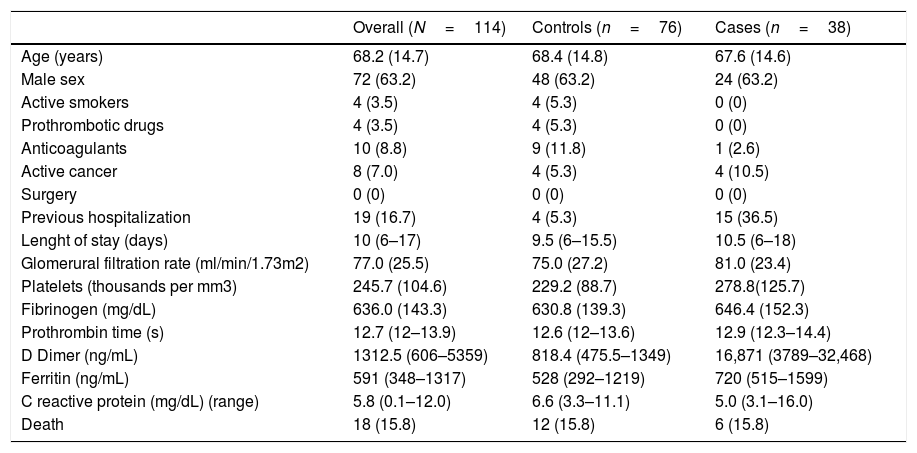D-dimer levels are elevated in COVID 19 and they correlate to the levels of other inflammatory markers such us ferritin, fibrinogen and C-reactive protein. It may be possible to correct D-dimer value in function of inflammatory markers, thus identifying patients at higher risk of venous thromboembolism (VTE). Our objectives are estimating a corrected value of plasma D-dimer as a linear function of ferritin, C-reactive protein and fibrinogen and stablishing a cut-off point of high probability of VTE.
Patients and methodsAge and sex matched case-control study of all patients diagnosed with COVID 19 and VTE between March and May 2020 in a tertiary hospital in Madrid (Spain). Using linear regression, the best predictive model will be estimated and residual D-dimer values will be obtained and analyzed using ROC curves to determine its discriminative performance.
ResultsThirty-eight cases and seventy-six controls were included. There was 63.2% of men and mean age was 68.2. D-dimer was best predicted by a linear model including fibrinogen, ferritin and C-reactive protein. Using residual values, the optimal cutoff point was 2165ng/mL, with a sensitivity of 57.9% and specificity of 98.7%.
ConclusionIt is possible to estimate a D-dimer corrected value in function of ferritin, C-reactive protein and fibrinogen. Using the observed and estimated value we can obtain a residual value that performs well as a screening method to detect patients who would benefit for further VTE diagnostic testing.
El dímero-D está elevado en la COVID-19 y se correlacionan con los niveles de otros marcadores inflamatorios como ferritina, fibrinógeno y proteína C reactiva. Cabe la posibilidad de corregir el dímero-D en función de dichos marcadores inflamatorios, identificando así los pacientes con mayor riesgo de enfermedad tromboembólica venosa (ETV). Nuestros objetivos son estimar un valor corregido de dímero-D como función lineal de ferritina, proteína C reactiva y fibrinógeno, y establecer un punto de corte de alta probabilidad de ETV.
Pacientes y métodosEstudio de casos y controles emparejados por sexo y edad de todos los pacientes diagnosticados con COVID-19 y ETV entre marzo y mayo de 2020 en un hospital terciario de Madrid, España. Mediante regresión lineal, se estima el mejor modelo predictivo y se obtiene el valor residual de dímero-D. Este se analizará con curvas ROC para determinar su capacidad discriminativa.
ResultadosSe incluyeron 38 casos y 76 controles. Había un 63,2% de varones y la edad media fue de 68,2 años. El valor de dímero-D fue predicho por un modelo que incluyó fibrinógeno, ferritina y proteína C reactiva. Usando los valores residuales, el punto de corte óptimo estimado de 2.165ng/ml, con una sensibilidad del 57,9% y una especificidad del 98,7%.
ConclusionesEs posible estimar un valor corregido de dímero-D en función de ferritina, fibrinógeno y proteína C reactiva. Usando el valor observado y estimado podemos obtener un valor residual que funciona bien como método de cribado para detectar pacientes que podrían beneficiarse de más estudios diagnósticos de la ETV.
Artículo
Comprando el artículo el PDF del mismo podrá ser descargado
Precio 19,34 €
Comprar ahora











